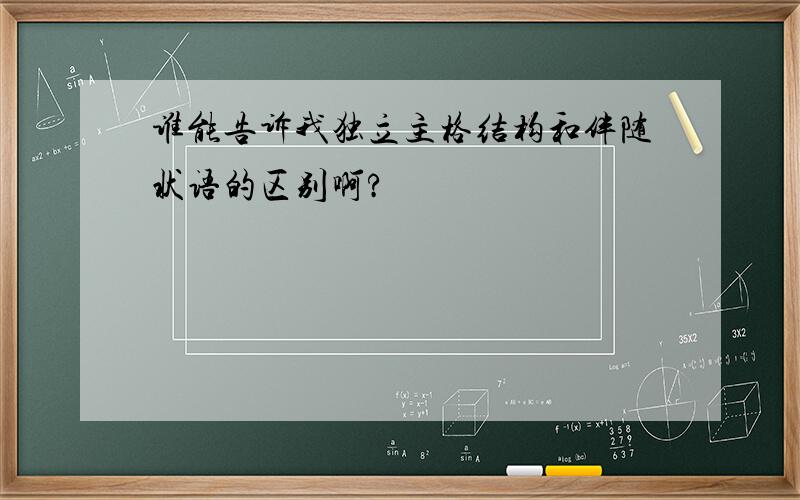谁能告诉我独立主格结构和伴随状语的区别啊?
来源:学生作业帮 编辑:搜狗做题网作业帮 分类:英语作业 时间:2024/04/26 17:49:39
谁能告诉我独立主格结构和伴随状语的区别啊?

独立主格结构有两部分组成,前一部份是名词或者代词,后一部分是非谓语动词或其他的一些词.前后两部分具有逻辑主谓关系.独立主格结构在句中做状语,多用于书面语. 独立主格结构本身不是句子,在句子中作状语,表示时间、原因、条件、伴随等.常见的独立主格结构有如下几种: 1. 名词/主格代词+现在分词.名词/主格代词与现在分词之间主谓关系.如: The girl staring at him (= As the girl stared at him), he didn”t know what to say. 姑娘两眼望着他,他不知道说什么好. Time permitting (= If time permits), we will go for an outing tomorrow. 如果时间允许的话,我们明天去郊游. 2. 名词/主格代词+过去分词.名词/主格代词与过去分词之间的动宾关系.如: The problems solved (= As the problems were solved), the quality has been improved. 随着问题的解决,质量已经提高了. Her glasses broken (= Because her glasses were broken), she couldn”t see the words on the blackboard. 由于眼镜摔坏了,她看不见黑板上的字. 3. 名词/主格代词+不定式.名词/主格代词与不定式之间是主谓关系,且强调的是一次具体性的动作.如: He is going to make a model plane, some old parts to help. 借助于一些旧零件,他要做一个飞机模型. They said good-bye to each other, one to go home, the other to go to the bookstore. 他们道别后,一个回了家,一个去了书店. 4. 名词/主格代词+形容词.如: An air accident happened to the plane, nobody alive. 那架飞机遭遇了空难,无一人生还. So many people absent, the meeting had to be called off. 这么多人缺席,会议不得不取消. 5. 名词/主格代词+副词.如: He put on his sweater wrong side out. 他把毛衣穿反了. The meeting over, they all went home. 会议一结束,他们就都回家了. 6. 名词/主格代词+介词短语.如: The boy goes to the classroom, book in hand. 那男孩手里拿着书去教室. Mary was sitting near the fire, her back towards the door. 玛丽靠近火炉坐着,背对着门. 独立主格结构的特点: 1)独立主格结构的逻辑主语与句子的主语不同,它独立存在. 2)名词或代词与后面的分词,形容词,副词,不定 式,介词等是主谓关系. 3)独立主格结构一般有逗号与主句分开. 举例: The test finished, we began our holiday. = When the test was finished, we began our holiday. 考试结束了,我们开始放假. The president assassinated, the whole country was in deep sorrow. = After the president was assassinated, the whole country was in deep sorrow. 总统被谋杀了,举国上下沉浸在悲哀之中. Weather permitting, we are going to visit you tomorrow. 如果天气允许,我们明天去看你. This done, we went home. 工作完成后,我们才回家. The meeting gone over, everyone tired to go home earlier. 会议结束后,每个人都想早点回家. He came into the room, his ears red with cold. 他回到了房子里,耳朵冻坏了. He came out of the library, a large book under his arm. 他夹着本厚书,走出了图书馆 伴随状语出现的条件是由一个主语发出两个动作或同一个生语处于两种状态,或同一个主语发出一个动作时又伴随有某一种状态.伴随状语的逻辑主语一般情况下必须是全句的生语,伴随状语与谓语动词所表示的动作或状态是同时发生的.伴随状语可以有以下几种表示方法: 一、使用分词形式 The dog entered the room, following his master(这条狗跟着主人进了屋). The master entered the room,followed by his dog(主人进了屋,后面跟着他的狗). 二、用with复合结构 The little girls were playing with snow with their hands frozen red(小女孩们在玩雪,手都冻红了). The workers went out of work, talking and laughing all the way(工人们下班了,一路有说有笑). 三、用独立主格结构 Last year I came here by climbing over the wall, sword in hand. The little boy goes to school, the little dog accompanying him every day(这小孩每天去上学,那条小狗陪伴着他). 四、用形容词 Crusoe went home, full of fear(克鲁索满怀恐惧地回家). Confident of the victory the players are fighting hard(运动员们对比赛夺胜满怀信心奋力拼搏). The match will be broadcast live(这场比赛将作实况转播). He left home young and came back old(他少小离家老大回). 五、用名词 He went away a beggar but retumed a millionaire(他讨吃要饭离家,腰缠万贯回归). He who had been twice prime minister of the country, died civilian(他曾两度出任这个国家的总理,而死的时候却是一个平民). 六、用介词短语 The girl came back to her mother in tears.(这女孩眼泪汪汪地回到母亲身边). How can you go to the wedding party in rags(你怎能衣衫褴褛地去参加婚宴)? I went home out of breath(我上气不接下气地回家).